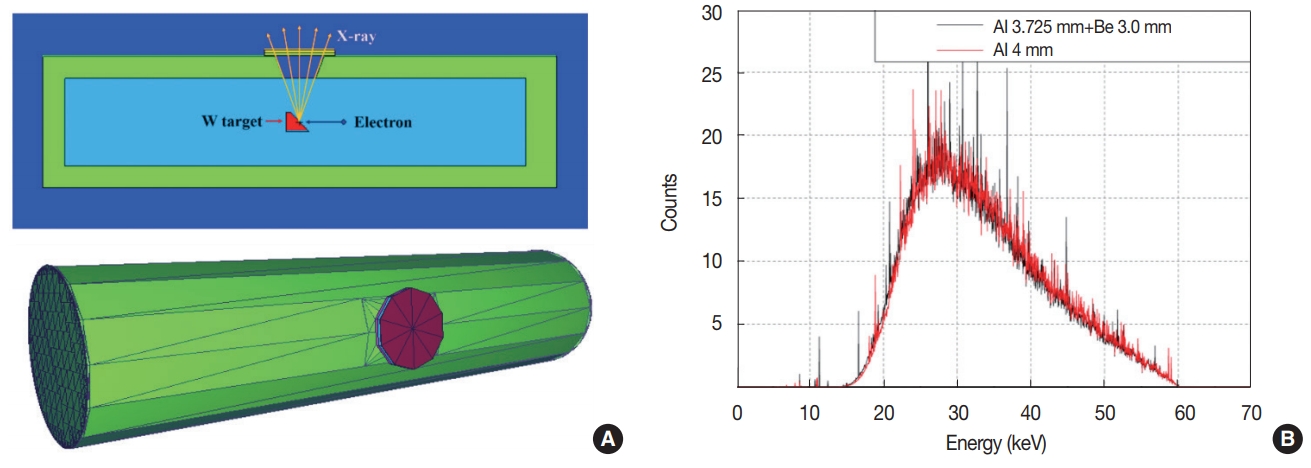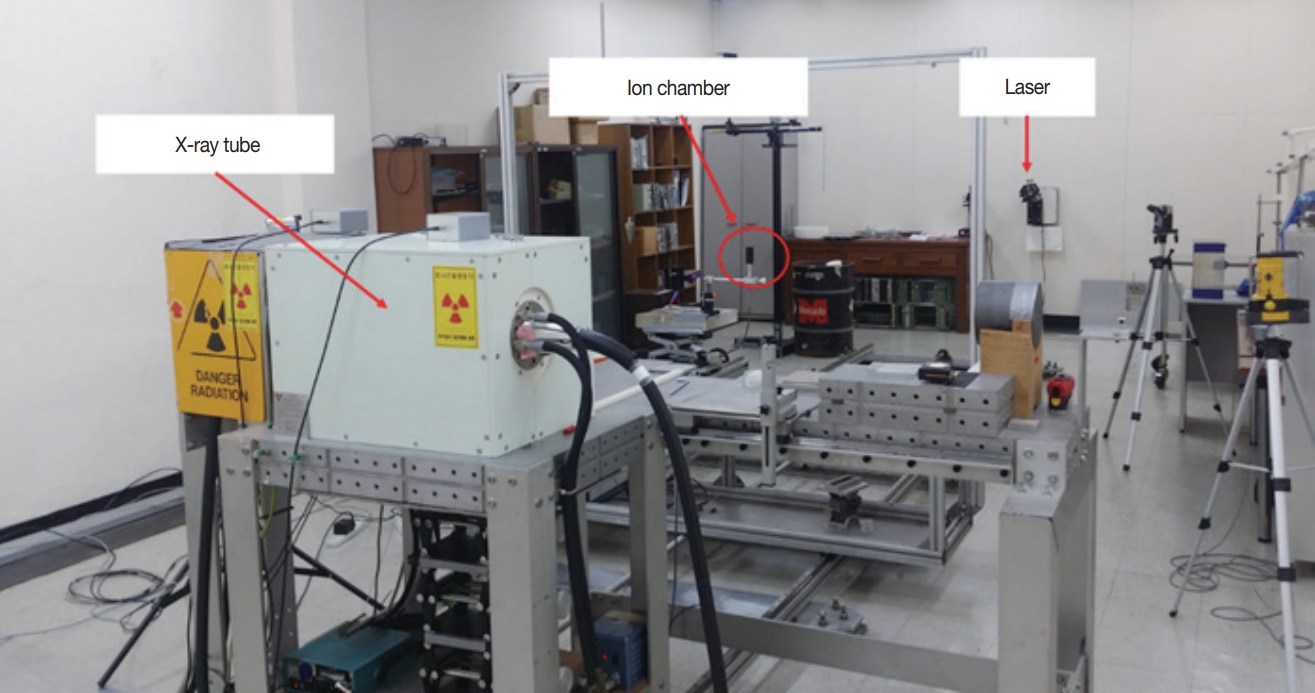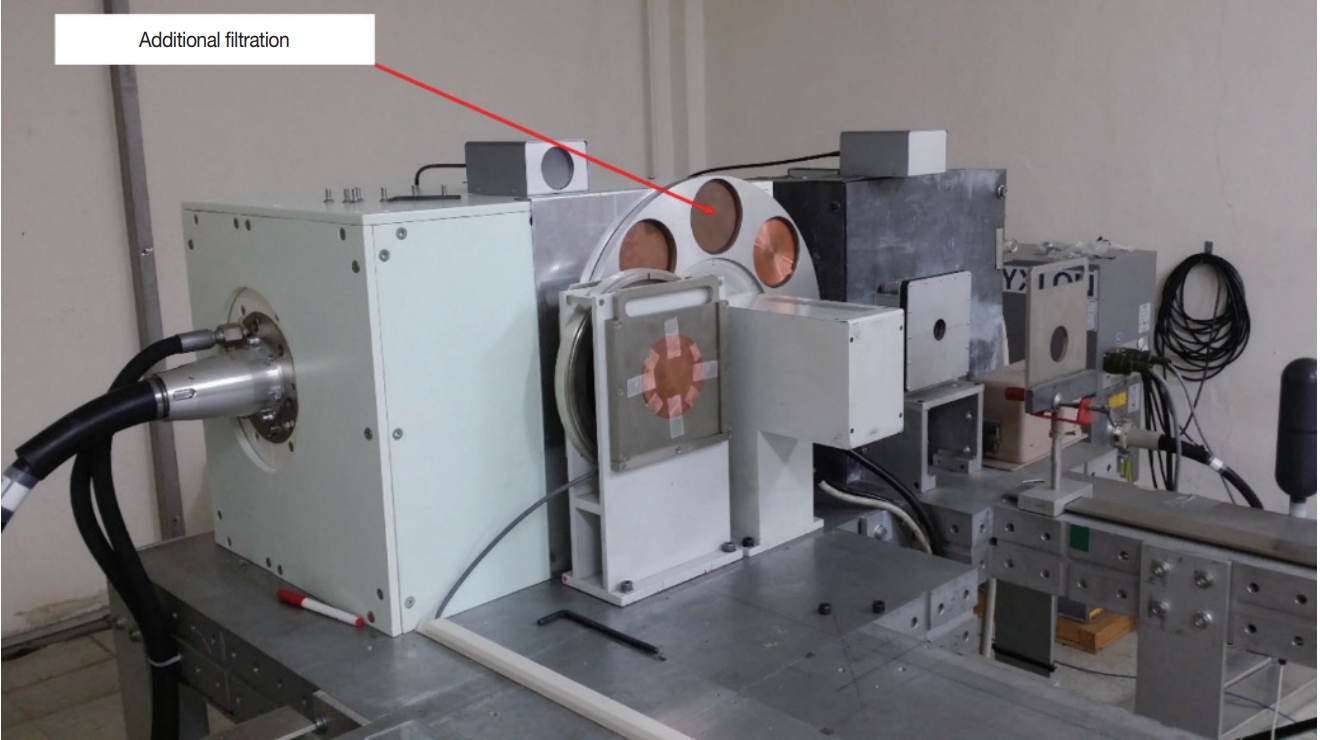Reference X-ray Irradiation System for Personal Dosimeter Testing and Calibration of Radiation Detector
Article information
Abstract
Background:
In the calibration and testing laboratory of Korea Atomic Energy Research Institute, the old X-ray generator used for the production of reference X-ray fields was replaced with a new one. For this newly installed X-ray irradiation system, beam alignment as well as the verification of beam qualities was conducted.
Materials and Methods:
The existing X-ray generator, Phillips MG325, was replaced with YXLON Y.TU 320-D03 in order to generate reference X-ray fields. Theoretical calculations and Monte Carlo simulations were used to determine initial filter thickness. Beam alignment was performed in three steps to deliver a homogeneous radiation dosage to the target at different distances. Finally, the half-value layers were measured for different X-ray fields to verify beam qualities by using an ion chamber.
Results and Discussion:
Beam alignment was performed in three steps, and collimators and other components were arranged to maintain the uniformity of the mean air kerma rate within ±2.5% at the effective beam diameter of 28 cm. The beam quality was verified by using half-value layer measurement methods specified by American National Standard Institute (ANSI) N13.11-2009 and International Organization for Standardization (ISO)-4037. For each of the nine beams than can be generated by the new X-ray irradiation system, air kerma rates for X-ray fields of different beam qualifies were measured. The results showed that each air kerma rate and homogeneity coefficient of the first and second half-value layers were within ±5% of the recommended values in the standard documents.
Conclusion:
The results showed that the new X-ray irradiation system provides beam qualities that are as high as moderate beam qualities offered by National Institute of Standards and Technology in ANSI N13.11-2009 and those for narrow-spectrum series of ISO-4037.
Introduction
Personal dosimeters and survey meters are the instruments used by radiation workers for monitoring and managing radiation dose. Photon energy responses can vary depending on the kind of dosimeters and survey meters used, and for their calibration, a reference radiation field is required. Korea Atomic Energy Research Institute (KAERI) has been designated a national radiation calibration and testing laboratory by the Korean government and has established reference radiation fields and a secondary standard dosimetry laboratory in accordance with Korean Industrial Standards (KS) and International Organization for Standardization (ISO) standards [1-3]. To establish infrastructure for national research projects in radiation dosimetry and ensure the reliability and high quality of reference irradiation for personal dosimeter performance testing and the calibration of the radiation detector, it is necessary to design and establish reference radiation fields and conduct beam quality assessment and verification in accordance with domestic and international standards. KAERI built a world-class reference radiation field and calibration and testing system back in 1992 and since then has been conducting research on radiation dosimetry and delivering technical assistance both domestically and internationally. In the reference radiation fields of KAERI, all types of radiation such as gamma, beta, X-rays and neutrons can be used. In particular, the reference X-ray field is designed to produce and use 20 different types of beams including beam qualities offered by National Institute of Standards and Technology (NIST) in American National Standard Institute (ANSI) N13.11-2009 and reference beam qualities by ISO-4037 with the use of an X-ray generator and rotation-type additional filtration system. The old X-ray generators were replaced with new ones, as they caused system instability and decreased output, and additional radiation fields needed to be built in accordance with international standards for testing personal dosimeter performance.
For testing the performance of personal dosimeter readout system and calibrating the radiation detector via X-ray radiation, regular doses of radiation need to be provided at specified positions and therefore, beam alignment should be performed for the new X-ray generators. The measurement of beam uniformity and half-value layer (HVL) of the reference X-ray field should be performed in order to ensure the beam qualities meet the international standards for X-ray fields [1].
In this study, 9 beam qualities of the new X-ray field were assessed, including NIST moderate beam qualities (M-series) and ISO narrow-spectrum (NS-series) beam qualities, and the quality of the reference X-ray field was investigated compared to the international standards of beam qualities.
Materials and Methods
1. Establishment of reference X-ray field
The existing X-ray generator, Phillips MG325, was replaced with YXLON Y.TU 320-D03 to construct reference X-ray fields. This generator has a maximum tube voltage of 320 kV and the voltage can be adjusted by 0.2 kV. The tube current can be adjusted by 0.05 mA, up to a maximum of 22.5 mA. At the maximum tube voltage, tube current can be set to a maximum of 13 mA. This generator has a maximum power of 4.2 kW and is equipped with a 3.0-mm beryllium filter [4]. The irradiator of the X-ray generator opens and closes by an electromagnet, in approximately 0.1 second. The entrance of the X-ray irradiation room and the door to the irradiator are locked by a safety lock to maintain control over radiation sources and immediately respond to any kind of radiation emergency. Laser positioning systems are installed on the wall and the upper part of the irradiator to match the radiation point to the calibration reference point and deliver radiation at any point in time.
As the inherent filter, a 3.0-mm beryllium filter is recommended for the X-ray field of NIST M-series with a tube voltage of 60 kV or higher. Filter materials equivalent to a 4.0-mm aluminum filter at the tube voltage of 60 kV are recommended by ISO for the X-ray field with a tube voltage of 60 kV [1, 5]. The X-ray generator of this study is equipped with a 3.0-mm beryllium window. An additional aluminum filter was installed to use the existing rotation-type additional filtration system. The thickness of the aluminum filter calculated from Equation 1 was 3.725 mm, and this was verified via Monte Carlo simulation. The geometry used in the simulation is shown in Figure 1A. Computer simulations were undertaken for bremsstrahlung X-rays produced by accelerated electrons on a tungsten target. The MCNPX code (2.7.0 version) was used for the simulations and ENDF/B-VI cross-section libraries were used. An F5 detector tally was used for measuring the energy distribution of bremsstrahlung X-rays.
All simulations were performed using tube voltages and tube currents. The results of the X-rays were compared with those from the 4-mm aluminum filter, as shown in Figure 1B. The simulation results showed an equivalence between the thickness of the filter installed by KAERI and the 4-mm aluminum filter in all energy intervals, with a deviation of ±5%.
2. Beam alignment of X-ray generator
Reference X-ray fields need to be designed to deliver a uniform dose of radiation at specified positions, in accordance with international standards. Therefore, beam alignment was performed in three steps, which include (1) primary beam alignment using lasers, (2) secondary beam alignment using an X-ray film and densitometer, and (3) tertiary beam alignment using an ion chamber.
First, the primary beam alignment was performed by physical methods using the horizontal and vertical laser positioning system to ensure that the new X-ray generator is aimed at the right angles, both vertically and horizontally, to the target. Physical beam alignment was performed to check whether the laser beam passes through the pinhole collimator and constantly points towards the window of the X-ray generator, by varying the collimator’s distances.
The secondary beam alignment was performed using an X-ray film and densitometer. An analysis was conducted on the X-ray images that were obtained at 100-cm and 200-cm distances from the focal point of the X-ray generator. The X-ray film cassette has a metal part with a pinhole at its center, which can determine whether the beam moves vertically. Figure 2A is the picture of the experimental setup for the secondary beam alignment using an X-ray film and densitometer. Figure 2B is the X-ray image obtained at 200-cm distance from the focal point of the X-ray generator. The reference distance between the X-ray generator and the target was adjusted by using the horizontal and vertical laser system for the primary beam alignment process. From the images of the pinhole collimator which was placed at the center of the film cassette, the vertical motion of the beam at the reference distance was confirmed. The relative beam intensity was measured by analyzing the X-ray film images from the densitometer at 5-mm intervals.

(A) Beam alignment process using an X-ray film, (B) the film image acquired by the X-ray irradiator, (C) results of beam alignment using a densitometer.
The method using X-ray film and densitometer has a variation in the results depending on the analyst. By this method, the relative distribution of X-ray beams can be determined, but it is difficult to determine the accurate distribution of an X-ray beam. For this reason, the tertiary beam alignment process was performed for more precise measurement and analysis. The beam uniformity was measured at 200-cm reference distance by using the Exradin A3 ion chamber (Active volume: 3.6 mm3). In this process, air kerma rates were measured at 1‐cm intervals using an ion chamber at the tube voltage of 60 kV and a tube current of 20 mA. Figure 3 is the picture of the experimental setup for the tertiary beam alignment. The air kerma rates of the X-ray generator were measured using the ion chamber by moving it in horizontal and vertical directions from the reference laser.
3. Half-value layer measurement
In this study, additional filtration was introduced in order to generate X-ray beams of uniform qualities and select the beam quality from nine beam qualities including the NIST M-series and ISO NS-series beams by rotation. Table 1 describes different types of additional filters from the NIST moderate series and those provided by KAERI. Table 2 shows the comparison of additional filters from the ISO NS-series and those provided by KAERI.

Results of the Air Kerma Rate Measurements Using an Ion Chamber (Expressed as Relative Deviation from the Average Air Kerma Rate in Percentage)
To compare the X-ray beam quality produced by KAERI with the use of the existing additional filter with beam qualities specified in the international standards, HVL measurements were conducted and the results were compared with those specified in NIST and ISO-4037, as shown in Figure 4. NE2530/1 ion chamber (Active volume: 35 mm3) was used for the HVL measurements. A total of nine beam qualities were analyzed at a reference distance of 200 cm. A measurement of air kerma rates for the HVL values stated in NIST and ISO-4037 was made, and values for the first and second HVLs were compared and checked to see if they conform to the values stated in NIST and ISO.
Results and Discussion
In this study, beam alignment was undertaken in three steps to deliver a uniform radiation dose to the target at different distances. The primary beam alignment was performed by physical methods using the horizontal and vertical laser positioning system to ensure that the focal point of the X-ray generator is at the center of the target. Figure 2C describes the measurement results of the X-ray film images obtained in the secondary beam alignment process by using the densitometer. The results showed that the X-ray generator generates a beam with a diameter of around 30 cm at the reference distance of 200 cm. The measurement with the densitometer showed that the intensity of the X-ray beam ranges from 0.58 to 0.61.
Finally, the tertiary beam alignment was performed to provide a more accurate beam distribution. Table 3 presents the results of air kerma rate measurements using an ion chamber. Each number listed in Table 3 is expressed as a percent deviation from the average air kerma rate. As shown in Table 3, uniformity of beam intensity was established with ±2.5% variation of the air kerma rate, within the beam diameter of 28 cm. This met the requirement of ISO-4037 concerning field uniformity, stating the 5% limit for variations in the air-kerma rate.
Tables 4 and 5 show the results of HVL measurements for NIST moderated series and ISO narrow spectrum series of beam and measurements by using the additional filter manufactured by KAERI, respectively.
ISO-4037 states that if the difference between the first and second HVL values of two X-ray beams is within ±5%, then these two X-ray beams can be considered as equivalent. The allowable error in the thickness of the filters used for the HVL measurements was set to be less than ±0.005 mm, and the filter materials with purity no less than 99.9% were used. The measurement results of the first and second HVLs using an ion chamber were shown in Tables 4 and 5, and the values are expressed as percent deviations between measurements with and without the HVL. In Tables 4 and 5, the agreement ratios are expressed as a percentage, and the homogeneity coefficient represents the ratio of the first HVL to the second HVL. As shown in Tables 4 and 5, the first and second HVLs differ by a maximum of 3.72%, and this met the requirement of the standard document stating ±5% limit for variation between the first and second HVLs. Therefore, the beams can be considered as equivalent to the beam qualities of the NIST M-series and ISO NS-series.
Conclusion
In this study, air kerma rates were measured for the first and second HVLs to ensure the effectiveness of beam alignment and beam qualities of the new X-ray irradiation system. The beam alignment was carried out in three steps to ensure uniformity of beam qualities and provide a more accurate beam distribution. The beam alignment was performed by physical methods using the laser positioning system to ensure that the new X-ray generator is aimed at the right angles, both vertically and horizontally, to the target. The final beam alignment process was performed using an X-ray film and ion chamber. As a result, the uniformity of beam intensity was established with ±2.5% variation of the air kerma rate, within a beam diameter of 28 cm, and this ensured the requirement ISO-4037 stating that field uniformity should not exceed 5%. Air kerma rates were measured for the first and second HVLs stated in NIST and ISO-4037 using an ion chamber. The results showed that the difference between the values was within ±5%, and this met the requirements for equivalent beam qualities stated in the standard documents. In conclusion, the beam qualities of the reference X-ray field from the new X-ray generator were found to meet the specifications of the NIST M-series and ISO NS-series beam qualities. Further measurements of X-ray spectra will be conducted by using a low-energy high-purity germanium detector to compare with the mean energy stated in the international standard documents. In addition, personal dosimeter performance testing and calibration of radiation detector will be continuously undertaken by using the new reference X-ray fields.
Acknowledgements
This work was supported by the National Research Foundation of Korea (NRF) grant funded by the Korea government (Ministry of Science and ICT) (No.2017M2A8A4015255) and the Nuclear Safety Research Program through the Korea Foundation Of Nuclear Safety (KoFONS) using the financial resource granted by the Nuclear Safety and Security Commission (NSSC) of the Republic of Korea (No.1605006).






